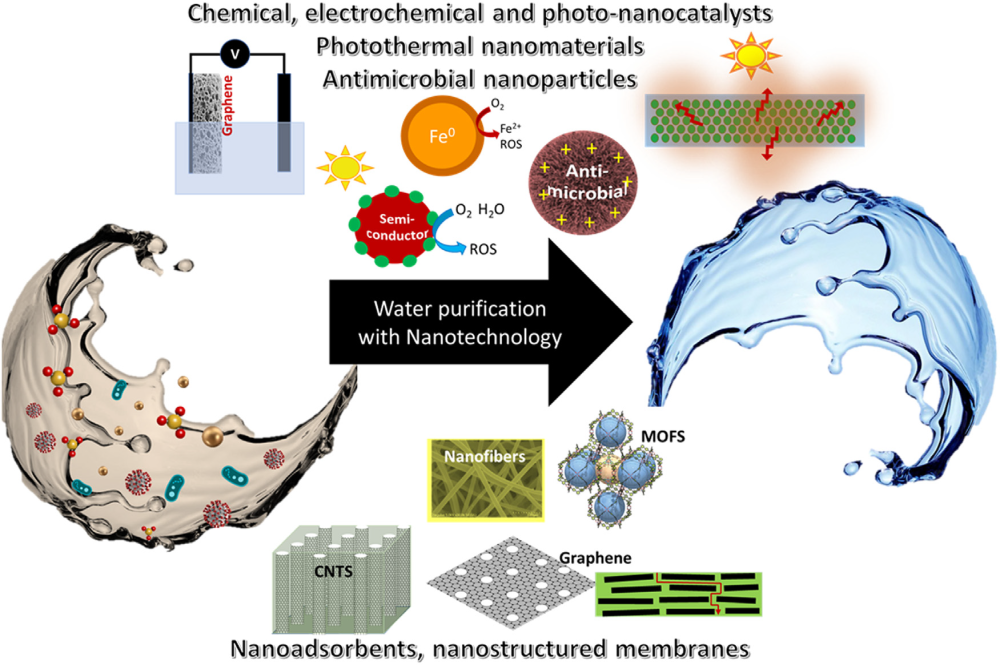As discussed in a paper published in the ‘Elsevier Reference Module in Chemistry, Molecular Sciences and Chemical Engineering’, the peculiar properties of nanomaterials and their behaviour at the interface with water can strongly enhance decontamination and remediation techniques. The most relevant contributions in this field, as well as the connected challenges, are presented in this work, which have many researchers from the ICN2 among its authors.

Nanotechnology holds great promise in addressing the global issue of water shortage, a growing problem due to climate change, depletion of natural resources and pollution. On one hand, it has enabled a better understanding of water at the nanoscale and its interactions with various surfaces. On the other, the extraordinary properties of nanomaterials can be harnessed to deliver faster, more efficient and more controlled strategies for water remediation.
A scientific paper recently published in ‘Elsevier Reference Collection in Chemistry, Molecular Sciences and Chemical Engineering’ explores the benefits brought about by new nanomaterials and nano-interfacial strategies for water remediation –including advanced catalytic, photothermal, adsorption, and filtration processes–, as well as the challenges still to be addressed. This study was carried out by researchers from various ICN2 groups –Dr Maria José Esplandiu, Dr Neus Bastus, Dr Jordi Fraxedas, Dr Inhar Imaz, Prof. Victor Puntes, and Dr Salvio Suárez-García— in collaboration with colleagues at the Catalan Institute of Water Research (ICRA), the Institute of Microelectronics of Barcelona (IMB-CNM-CSIC) and the Institute of Nanoscience and Nanotechnology of the University of Barcelona (IN2UB).
The paper provides a brief description of the peculiar structure of water and its interactions with surfaces at the nanoscale, as well as an introduction to the water shortage problem. Then, it moves on to discussing in details how nanotechnology can be applied to enhance most of the current water purification techniques, focusing specifically on the processes that occur at the nano-interfaces.
Nanomaterials are known for exhibiting unique properties, such as large surface-to-volume ratio and high density of active sites, which boost their chemical reactivity and adsorption capabilities. This translates into greater efficiency in capturing and degrading contaminants in water. In addition, miniaturization and quantum confinement give rise to new optical, electronic, and magnetic properties, while the specific size of semiconductor nanoparticles determines their optoelectronics characteristics. All these discoveries have provided new routes towards increasing the efficiency of water quality restoration processes.
Nevertheless, there are still a few issues to be tackled, as highlighted in the paper. In particular, together with the desired interfacial reactions, often unwanted collateral processes are boosted as well. Thus, further studies are needed to prevent or minimise these negative effects, such as (photo-) corrosion, poisoning, fouling, etc. Furthermore, efforts will be dedicated to ensuring the reusability, durability and recyclability of new materials and devices for water remediation.
Reference article:
M.J. Esplandiu, N. Bastus, J. Fraxedas, I. Ihmaz, V. Puntes, J. Radjenovic, B. Sepúlveda, A. Serrá, S. Suárez-García, G. Franzese, Interfacial phenomena in nanotechnological applications for water remediation. Reference Module in Chemistry, Molecular Sciences and Chemical Engineering, Elsevier, 2023. DOI: 10.1016/B978-0-323-85669-0.00066-0

